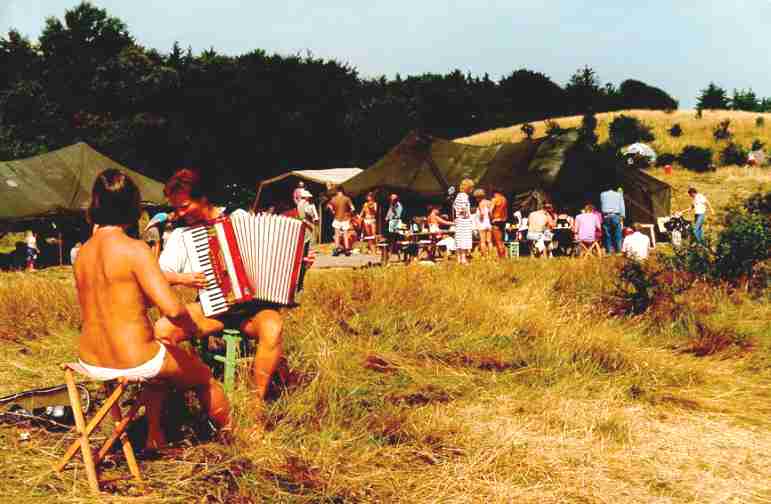
Trippevals "353" (Mince Waltz no. 353) |
| Niels Mejlhede Jensen, Bøgeløvsvej 4, 2830 Virum, Denmark. e-mail (web master) |
CONTENTS: (remember: you can use Ctrl Home in usual browsers to get to the top of this page, to the links here)

Photo of this week: Summer folk dance and music tent camp on
the island of Fur in Limfjorden in Northern Jutland. (We have now changed
the clock from winter to summer time in Europe and think of some nice summer
events with folk dancing). The two girls in the front of the picture, sitting
here in the nature a nice warm summer day can just pick their instruments
and play the most wonderful music to a height quite above my abilities.
Others are playing in the background in front of the big tents (tents for
use in case of rain). On the ground there is placed a wooden floor for
folk dance. 100 metres behind me (taking the picture) there is a good beach
and a splendid view of Limfjorden's waters. Most private tents are placed
close to this view.
Dance of the week, 1999, April 5:
The melody can be heard in midi on computer piano in my tempo (if you
have a sound card). (The melody will loop here until you stop it. In the
table below it will play once). (I have not played the tunes here with
the "drive" I want for dance music).
| 1 | melody | the traditional good dancing melody, polished through generations of use on the fiddle | |
| . | chord
text |
Midi metronome = 170 | simple (folk music) chords, natural for playing the accordion;
these chords are used to make the other parts or voices in triad harmony; there should be no tension from dissonance anywhere including in octave |
| 2 | A | (Above), parallel part nearest above in third or little more above | |
| 3 | B | (Below), parallel part nearest below in third or little more below | |
| 4 | ns | simple n part; often with the tonic feeling and often with the basic dance rhythm ("motor part") | |
| 5 | C1 | C parts are made from A and B parts, and so they are two parts to the melody | |
| 6 | C2 | C2 is less simple than C1 | |
| 7 | mod =
contra part |
voice up and down (mostly) contra to the melody; it is also made from A and B | |
| 8 | C1 | octave up | |
| 9 | C2 | octave down | |
| 10 | mod | octave down | |
| 11 | A | octave up | |
| 12 | B | octave up | |
| 13 | blank | . | blank staff for making your own part according to the principles here |
(The midi music is not repeated, except for 1' and 2' voltas).
Use also octave, up and down.
Where wanted, notes can be changed according to the principles (use
a colour pencil), e.g. to improve the B part with some notes from
A.
The music is aimed at dancing, so part of the orchestra can be the
underlying "motor" when another instrument group is playing its "solo"
part (improvisation) as one of the many repetitions.
The double bass may play its usual notes, because of its low pitch.
It is better to choose a more simple part and play it well.
Observe the ns part and specially C1 part: how they are made to promote
a distinct trippevals = mince waltz, and not an ordinary waltz or
Vienna waltz: typically 3 times the same note per bar pounding with about
equal beats. Or should we say: that typically the notes on beat 1 and beat
2 are the same, to make it distinct different from an ordinary waltz (where
it is important to have notes of different pitches on beat 1 and beat 2
to be able to make a good slur). We could reduce the saying to: that it
is valuable to have the first 2 bars according to that rule, so that the
right feeling is introduced for the musician. Observe that this very good
typical trippevals = mince waltz in its old melody has all the same principles.
(In a big band (= orchestra) with a good underlying mince waltz motor
of e.g. ns and C1 parts, the solo parts like C2, mod = contra voice, and
n1 (n1 is not included here), can then be made different from these rules,
so that the solo player on flute, oboe, french horn, bassoon, etc., here
can express her personal and instrumental feelings). I have for this dance
here made C2 and contra parts also as mince waltz music.
Accordion: beats per bar: 1+2
3 short beats per bar about equally marked (beat 1 most marked as always),
not staccato (but portato), not waltz (i.e. not slur form beat 1
to beat 2)
(Help coming back from that note
sheet: CLICK the note sheet to come back to this page, or just close
the note window.
Remember: the note sheet opens in a new separate window, and that may
cover the whole screen. The back button in the tools bar does probably
not work because the window is new, with no history. All you see on the
page are notes because I have placed no link back here for not disturbing
easy submitting to the printer. Close the note window with a click at the
top or with Alt F4, or minimize or reduce the window, or ..., and you are
back to the main page that was there behind all the time).